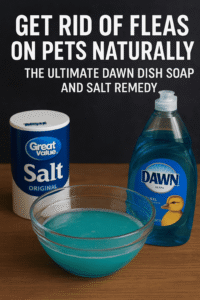ADVERTISEMENT
ADVERTISEMENT
ADVERTISEMENT
Dawn Dish Soap and Salt
Introduction
If you’re a pet parent, you know how frustrating fleas can be. These tiny parasites cause itching, discomfort, and even skin infections in dogs and cats. While there are many flea treatments available on the market, some can be expensive or contain harsh chemicals. Fortunately, there’s an affordable and effective home remedy you may already have in your kitchen: Dawn dish soap and table salt.
In this guide, we’ll explain why this simple solution works, how to use it safely on your furry friend, and extra tips to keep fleas away for good.
What Are Fleas and Why Are They a Problem?
Fleas are small, wingless insects that feed on the blood of animals. Despite their size, they can jump impressive distances and quickly infest your home and pets.
Why they’re dangerous:
-
Cause intense itching and scratching.
-
Can lead to hair loss, skin infections, and allergic reactions.
-
May transmit tapeworms and other diseases.
-
Female fleas lay up to 50 eggs per day, making infestations grow fast.
If left untreated, fleas don’t just bother your pet—they can spread through your house, carpets, and furniture. That’s why tackling them early is crucial.
Why Dawn Dish Soap Works Against Fleas
Dawn dish soap is more than just a grease fighter for dirty dishes—it’s also a powerful flea remedy. Here’s why:
-
Breaks down the flea’s exoskeleton: The soap destroys the protective outer layer of fleas, killing them on contact.
-
Removes oils from fur: Fleas cling to oils in your pet’s coat, but Dawn strips away that layer, making it harder for fleas to hold on.
-
Safe for most pets: Unlike harsh chemicals, mild dish soap (especially the original blue Dawn) is gentle enough for occasional use on dogs and cats.
It’s even been used by wildlife rescue organizations to clean oil off birds after oil spills, which proves its gentleness when used properly.
How Salt Helps in Flea Control
Salt is another household staple that plays a role in fighting fleas. Here’s how it works:
-
Natural dehydrator: Salt dries out flea eggs and larvae, breaking the flea life cycle.
-
Affordable and safe: Table salt is non-toxic when used correctly and easy to sprinkle in problem areas like carpets and pet bedding.
-
Enhances soap solution: When mixed with Dawn, salt boosts the flea-killing effect by creating a harsher environment for the pests.
ADVERTISEMENT

ADVERTISEMENT
Step-by-Step Guide: Using Dawn Dish Soap and Salt on Pets
What You’ll Need:
-
1–2 tablespoons of Dawn dish soap (blue original formula recommended)
-
2–3 tablespoons of table salt
-
Warm water
-
A large bowl or basin
-
A flea comb
-
Towels for drying
Instructions:
-
Prepare the Mixture
-
In a bowl, mix warm water with a tablespoon of Dawn dish soap.
-
Add 1–2 tablespoons of salt and stir until it dissolves.
-
-
Wet Your Pet’s Fur
-
Gently soak your pet’s coat with lukewarm water. Avoid getting water in their ears, eyes, or nose.
-
-
Apply the Solution
-
Massage the Dawn and salt mixture into your pet’s fur, making sure it reaches the skin.
-
Focus on flea-prone areas: behind the ears, under the legs, near the tail, and around the neck.
-
-
Wait and Comb
-
Leave the mixture on your pet for 5 minutes (no longer, to avoid skin dryness).
-
Use a flea comb to remove dead fleas, eggs, and debris.
-
-
Rinse Thoroughly
-
Rinse your pet’s fur with warm water until all soap is gone.
-
Soap residue can irritate the skin if left behind.
-
-
Dry and Comfort
-
Towel dry your pet and give them a gentle brush.
-
Offer a treat to make bath time a positive experience.
-
Important Safety Tips
While this remedy is safe for most pets, there are precautions to follow:
-
Do not use too often: Dawn can dry out your pet’s skin if used daily. Limit to once a week or less.
-
Check for allergies: Some pets may have sensitive skin. Test a small patch first.
-
Avoid kittens and puppies under 8 weeks: Their skin is too delicate for dish soap.
-
Don’t use salt directly on skin: Salt works best in the solution or sprinkled on carpets/bedding, not directly rubbed into fur.
-
Consult your vet: If your pet has severe flea infestations or skin conditions, get professional advice before trying home remedies.
Using Salt Around the Home
Fleas don’t just live on your pet—they thrive in your home environment. Here’s how to use salt indoors:
-
Carpets & Rugs
-
Sprinkle fine table salt across carpets and rugs.
-
Leave for 24–48 hours, then vacuum thoroughly.
-
-
Pet Bedding
-
Wash all bedding in hot, soapy water.
-
Sprinkle salt on bedding before washing for extra flea-killing power.
-
-
Furniture & Cracks
-
Lightly dust salt in corners, under cushions, and along baseboards where fleas may hide.
-
Repeat weekly until fleas are gone.
Other Natural Flea Remedies to Try
If you want to add variety to your flea-fighting toolkit, consider these natural alternatives:
-
Apple Cider Vinegar Spray: Mix equal parts vinegar and water, spray lightly on your pet’s coat.
-
Lemon Spray: Boil sliced lemons in water, let cool, and spray on flea-prone areas.
-
Diatomaceous Earth (Food Grade): Sprinkle on carpets and pet bedding—kills fleas by dehydrating them.
-
Essential Oils (with caution): Oils like lavender and cedar repel fleas but must be used sparingly and never directly on cats.
Long-Term Flea Prevention Tips
Home remedies work, but prevention is key to keeping your pet comfortable year-round.
-
Regular Grooming: Brush your pet daily and check for flea dirt (tiny black specks).
-
Wash Bedding Often: Keep your pet’s bedding clean to stop flea eggs from hatching.
-
Vacuum Frequently: Flea eggs and larvae hide in carpets and upholstery.
-
Yard Care: Mow your lawn and keep outdoor spaces clean to prevent flea breeding.
-
Vet-Approved Preventatives: Use flea collars, topical treatments, or oral medications for long-term protection.
Final Thoughts
Fleas are pesky, but with the right approach, you can keep them under control without breaking the bank. A mixture of Dawn dish soap and table salt is a simple, affordable, and surprisingly effective home remedy that kills fleas on contact and disrupts their life cycle.
However, remember that while this method works well as a quick fix, it should not replace professional veterinary care or long-term flea prevention. Combine this remedy with good hygiene, regular grooming, and vet-recommended treatments to keep your furry friend happy, healthy, and flea-free.
For more recipes follow me in Facebook , Pinterest !
ADVERTISEMENT

